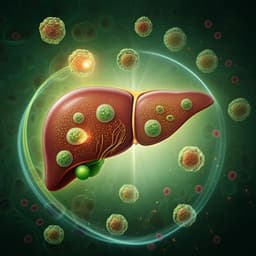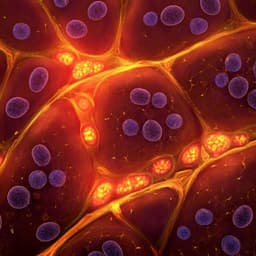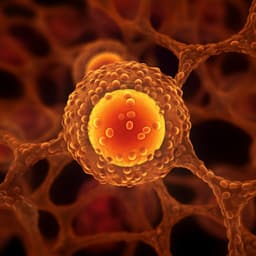
Medicine and Health
Itaconic acid underpins hepatocyte lipid metabolism in non-alcoholic fatty liver disease in male mice
J. M. Weiss, E. M. Palmieri, et al.
Discover the groundbreaking research by Jonathan M. Weiss and colleagues, which unveils the role of itaconic acid in mitigating lipid accumulation in liver diseases. This study investigates how macrophage-derived itaconate can potentially reverse adverse metabolic conditions in non-alcoholic fatty liver disease.
~3 min • Beginner • English
Introduction
Non-alcoholic fatty liver disease (NAFLD) is a prevalent metabolic disorder linked to excess caloric intake, obesity, insulin resistance, and inflammation. The liver is central to lipid homeostasis, balancing uptake, storage, oxidation, and export of triglycerides and fatty acids. Steatosis arises when lipid availability exceeds removal via fatty acid oxidation (FAO) or lipoprotein secretion. The authors hypothesized that, beyond acetyl-CoA and classical regulators, other metabolic intermediates modulate hepatic lipid metabolism. Prior work implicated the immunometabolite itaconate, produced by Irg1 (Acod1) in activated macrophages, in regulating β-oxidation, mitochondrial ROS, and OXPHOS. Here, the study investigates whether itaconate produced by hepatic macrophages influences hepatocyte FAO and lipid handling during NAFLD, and whether augmenting itaconate can ameliorate dyslipidemia.
Literature Review
Background literature highlights acetyl-CoA as a central node linking glycolysis, β-oxidation, and lipid synthesis. Itaconate, generated from cis-aconitate by Irg1/Acod1 in inflammatory macrophages, has been described as an anti-inflammatory immunometabolite implicated in cancer, infection, sepsis, and tissue injury. Prior studies showed itaconate can modulate β-oxidation and mitochondrial ROS in macrophage-lineage cells and protect hepatocytes in ischemia/reperfusion via Nrf2 activation. Itaconate can be converted to itaconyl-CoA by succinyl-CoA ligase; a ‘CoA sink’ mechanism was proposed, as well as inhibition of mitochondrial complex II and methylmalonyl-CoA mutase. The NAFLD literature emphasizes roles of Kupffer cells (KCs), recruited hepatic macrophages, and lipid-associated macrophages in adipose tissue in driving inflammation and remodeling, with interferon signaling pathways contributing to macrophage programming. Emerging single-cell datasets in NAFLD show dynamic macrophage niche changes and Irg1 upregulation in recruited macrophages over prolonged high-fat feeding.
Methodology
Animal models: Male C57BL/6J mice (8–12 weeks) were used. Global Irg1 knockout (Irg1−/−), myeloid-specific Irg1 deletion (Irg1fl/fl × LysMCre), and hepatocyte-specific Irg1 deletion (Irg1fl/fl × AlbCre) lines were studied. NAFLD was induced by a Western diet (Research Diets) plus 10% sucrose water for 12 weeks ad libitum. Some mice received 4-octyl itaconate (4-OI; 50 mg/kg, i.p., 3×/week for 12 weeks) in 40% cyclodextrin/PBS; vehicle controls received cyclodextrin/PBS.
Human samples: Frozen liver tissue from 16 NASH patients and 10 non-NASH controls (diagnoses included hemangioma, focal nodular hyperplasia, hepatic adenoma, hepatocellular carcinoma, benign) were analyzed by qPCR and mass spectrometry.
Cell isolation and assays: Liver F4/80+ macrophages were isolated by collagenase/dispase/DNase digestion and magnetic selection (>97% purity). Primary mouse hepatocytes were isolated and treated with sodium itaconate (typically 10 mM, unless noted) and/or chemically defined lipid mix (usually 1:10 dilution). LPS treatments were used to probe inducible itaconate production in vivo and in vitro.
Histology and lipid staining: Oil Red O (ORO) staining on frozen liver sections; F4/80 immunohistochemistry (DAB or alkaline phosphatase) on liver/adipose to assess macrophage content and crown-like structures (CLSs). BODIPY 493/503 staining in macrophages and hepatocytes quantified by flow cytometry or imaging.
Metabolic profiling: Broad and targeted metabolomics and lipidomics were performed using UHPLC-QTOF MS and ESI-LC-MS/MS. Itaconate levels in plasma and liver were quantified via standard curves. Acyl-CoA profiling (including itaconyl-CoA, succinyl-CoA, malonyl-CoA, acetyl-CoA) used LC-quadrupole/orbitrap high-resolution MS. 13C tracing: U-13C16 palmitate labeling (200 µM, 4 h) assessed incorporation into TCA intermediates.
Seahorse extracellular flux: Oxygen consumption rate (OCR) and extracellular acidification rate (ECAR) measured after overnight treatments; modulators included etomoxir (40 µM), oligomycin, FCCP, rotenone/antimycin A to derive basal, maximal, and ATP-linked OCR.
Glucose/insulin homeostasis: Glucose tolerance test (2 g/kg i.p., after 16 h fast); insulin tolerance test (0.5 U/kg i.p., after 5 h fast); serum insulin ELISA; free fatty acids and triglycerides measured by colorimetric kits; liver/adipose triglycerides quantified from homogenates.
Gene expression: qPCR for murine and human Irg1, and IL6 in human samples; housekeeping genes HPRT/GAPDH. Bulk RNA-seq on treated hepatocytes; differential expression by ANOVA; Gene Set Enrichment Analysis (GSEA) of KEGG pathways.
Statistics: Two-way ANOVA with multiple comparisons unless noted; Mann–Whitney U-test for non-normal human data; multiple t-tests for large omics datasets. Significance at P<0.05 with standard notation.
Key Findings
- Irg1/itaconate upregulation in NAFLD/NASH:
• In WD-fed mice, hepatic Irg1 mRNA increased by 12 weeks; expression localized to myeloid cells (lost in Irg1fl/fl × LysMCre, preserved in Irg1fl/fl × AlbCre). Irg1 upregulation depended on IFNAR but not Stat1, suggesting non-canonical type I IFN signaling. F4/80+ hepatic macrophages accumulated itaconate; F4/80− fractions and hepatocytes did not. LPS failed to induce hepatocyte itaconate in vivo or in vitro.
• Liver itaconate in WD-fed mice: ~400 ± 131 µM (significantly above control); no increase in blood itaconate after WD.
• Human NASH livers showed increased Irg1 mRNA and higher itaconate (~109 ± 9 µM) vs non-NASH controls; plasma itaconate unchanged.
- Loss of Irg1 worsens dyslipidemia and metabolic dysfunction:
• Irg1−/− and Irg1−/− × LysMCre mice displayed increased hepatic lipid accumulation (ORO, H&E), elevated liver triglycerides, and higher circulating free fatty acids, on both control and WD. No significant changes in serum triglycerides or cholesterol; adipose triglycerides unchanged.
• Irg1−/− mice developed glucose intolerance (GTT AUC P=0.04), insulin resistance (ITT AUC P=0.031), and elevated serum insulin (P=0.03 to 0.001), without differences in body weight or food intake compared with WT.
• Hepatic and adipose tissue F4/80+ macrophages were reduced in Irg1−/− mice on WD, with fewer hepatic and adipose crown-like structures.
- Therapeutic effect of 4-octyl itaconate (4-OI):
• Single 4-OI administration produced transient high plasma itaconate and a liver peak at ~4 h, returning to baseline by 24 h.
• Chronic 4-OI treatment (50 mg/kg, 3×/week, 12 weeks) reduced hepatic ORO staining (sum droplet area and average droplet size; P=0.015 to <0.0001) and mesenteric fat weight (P=0.014) in WD-fed Irg1−/− mice; minimal effect in WT.
- Hepatocyte-intrinsic effects of itaconate:
• Exogenous itaconate accumulated in hepatocytes and reduced neutral lipid (BODIPY) accumulation in primary hepatocytes across doses (as low as 0.1 mM) and in HepG2 cells; targeted lipidomics showed decreases in multiple triglycerides and acylcarnitines.
• Itaconate enhanced lipid-stimulated OCR in hepatocytes; effect was abolished by etomoxir, indicating dependence on fatty acid β-oxidation. Itaconate also increased ECAR; basal and maximal OCR rose with lipid and/or itaconate; ATP-linked OCR unchanged.
• 13C-palmitate tracing indicated increased incorporation into TCA intermediates with itaconate in lipid-challenged hepatocytes.
- Mechanism: mSLP suppression and compensatory FAO/glycolysis
• Itaconate increased itaconyl-CoA levels; did not alter succinyl-CoA, malonyl-CoA, or acetyl-CoA. CoASH supplementation did not reverse lipid reductions, arguing against a CoA-sink mechanism.
• Itaconate lowered ATP and increased ADP, elevating ADP:ATP ratios, consistent with consumption of ATP during itaconate activation and suppression of mitochondrial substrate-level phosphorylation (mSLP). This energetic shift likely drives compensatory increases in FAO and glycolysis to restore ATP and reduce lipid burden.
- Transcriptional programs:
• Minimal changes in Nrf2 target gene expression in hepatocytes exposed to itaconate; fatty acid oxidation KEGG pathway showed no significant enrichment by GSEA despite modest changes in a few genes.
Discussion
The study demonstrates that itaconate, produced by hepatic macrophages during NAFLD/NASH, acts in trans on hepatocytes to enhance fatty acid β-oxidation and oxidative phosphorylation, thereby lowering lipid accumulation. This addresses the hypothesis that immunometabolic intermediates directly regulate hepatic lipid handling. The data reconcile prior observations of Irg1 in macrophage inflammatory biology with a metabolic role in hepatocytes. Itaconate’s effects were largely metabolic rather than transcriptional, with evidence supporting suppression of mitochondrial substrate-level phosphorylation and consequent shifts in ADP:ATP that stimulate FAO and glycolysis. The WD model revealed Irg1 induction in recruited hepatic macrophages via IFNAR-dependent, Stat1-independent signaling, aligning with single-cell studies showing macrophage niche remodeling in NAFLD. Therapeutically, 4-OI delivery achieved liver itaconate levels sufficient to reverse steatosis and mesenteric adiposity in Irg1-deficient mice, suggesting potential for targeting itaconate pathways in metabolic disease. Notably, Nrf2 activation was minimal in hepatocytes treated with unmodified itaconate, distinguishing these effects from electrophilic itaconate derivatives and indicating context- and cell type-dependent outcomes.
Conclusion
This work identifies a mechanistic link between the immunometabolite itaconate and hepatic lipid metabolism: macrophage-derived itaconate promotes β-oxidation and OXPHOS in hepatocytes, reducing steatosis and improving metabolic parameters in a NAFLD model. Irg1/itaconate is elevated in both mouse NAFLD and human NASH livers, underscoring clinical relevance. Exogenous itaconate (via 4-OI) reversed dyslipidemia in Irg1-deficient mice, revealing a therapeutic avenue. Mechanistically, itaconate increases itaconyl-CoA and shifts ADP:ATP via suppression of mitochondrial substrate-level phosphorylation, driving compensatory FAO and glycolysis. Future research should: (1) evaluate itaconate’s impact on other hepatic cell types (e.g., stellate cells) and fibrosis; (2) define dosing, delivery, and safety of itaconate/derivatives in vivo; (3) dissect IFNAR-dependent pathways controlling Irg1 in NAFLD; and (4) validate efficacy in additional preclinical models and human systems.
Limitations
- Sex and model specificity: Only male mice were used; female rodents often differ in diet-induced obesity responses. The primary model was a 12-week Western diet with sucrose; generalizability to other NAFLD/NASH models and durations requires testing.
- Cell-type scope: While hepatocytes were the focus, effects on other liver cells (e.g., hepatic stellate cells) were not directly tested and may contribute to outcomes.
- Mechanistic nuances: Although data support mSLP suppression over a CoA-sink mechanism, comprehensive mapping of involved enzymes and fluxes is incomplete. Transcriptional analyses showed minimal pathway-level changes; subtle or post-translational mechanisms may be underappreciated.
- Immune contributions: Despite evidence that hepatocyte Irg1 is dispensable in this model, contributions from macrophage subsets and neutrophils cannot be fully excluded.
- Therapeutic translation: 4-OI reversed pathology primarily in Irg1−/− mice and had limited effect in WT, suggesting baseline itaconate sufficiency or ceiling effects; dosing, off-targets, and long-term safety remain to be defined.
- Human data are correlative: Elevated Irg1 and itaconate in NASH livers support relevance but do not establish causality in humans.
Related Publications
Explore these studies to deepen your understanding of the subject.







